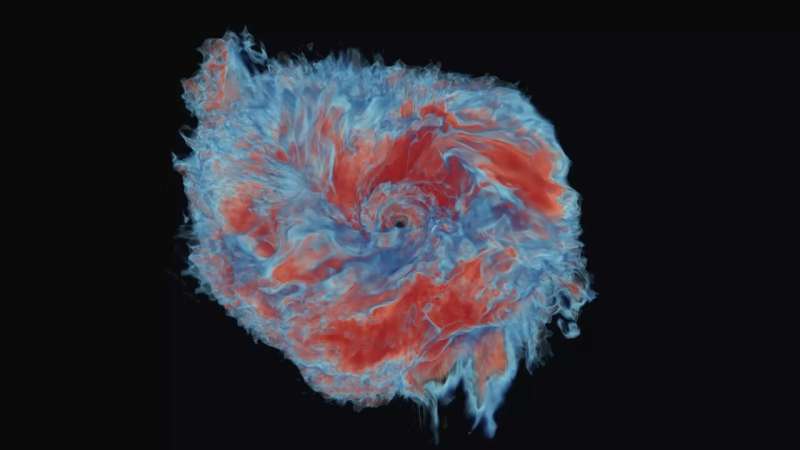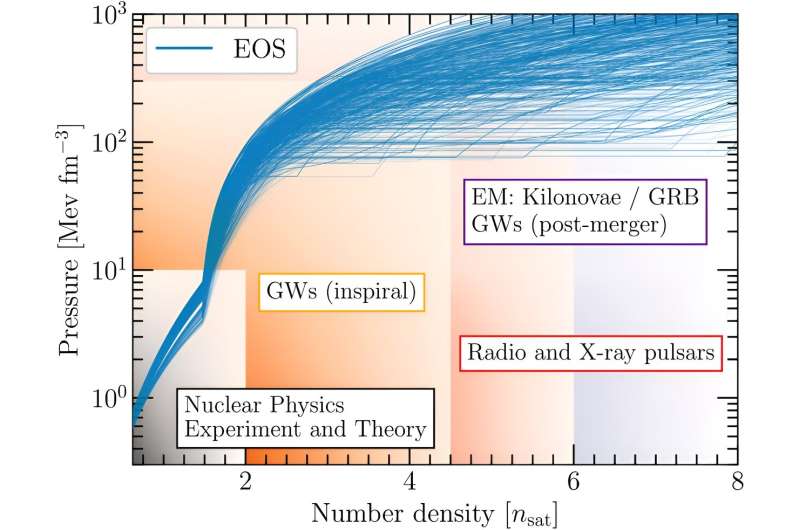This article has been reviewed according to Science X's editorial process and policies. Editors have highlighted the following attributes while ensuring the content's credibility:
fact-checked
peer-reviewed publication
trusted source
proofread
Research team models different signatures of a kilonova explosion simultaneously for the first time

Neutron stars are the end products of massive stars and gather together a large part of the original stellar mass in a super-dense star with a diameter of only around ten kilometers. On 17 August 2017, researchers observed the manifold signatures of an explosive merger of two orbiting neutron stars for the first time: gravitational waves and enormous bursts of radiation, including a gamma-ray burst.
An international research team has developed a method to simultaneously model these observable signals of a kilonova. This enables them to precisely describe what exactly happens during a merger, how nuclear matter behaves under extreme conditions, and why the gold on Earth must have been created in such events.
Using a new software tool, a team involving the Max Planck Institute for Gravitational Physics and the University of Potsdam has simultaneously interpreted the various types of astrophysical data from a kilonova.
In addition, data from radio and X-ray observations of other neutron stars, nuclear physics calculations, and even data from heavy-ion collision experiments on earthbound accelerators can be used. Until now, the various data sources have been analyzed separately, and the data interpreted using different physical models in some cases.
"By analyzing the data coherently and simultaneously, we get more precise results," says Peter T. H. Pang, a scientist at Utrecht University.
"Our new method will help to analyze the properties of matter at extreme densities. It will also allow us to understand better the expansion of the universe and to what extent heavy elements are formed during neutron star mergers," explains Tim Dietrich, professor at the University of Potsdam and head of a Max Planck Fellow group at the Max Planck Institute for Gravitational Physics.

Extreme conditions in a cosmic laboratory
A neutron star is a superdense astrophysical object formed at the end of a massive star's life in a supernova explosion. Like other compact objects, some neutron stars orbit each other in binary systems. They lose energy through the constant emission of gravitational waves—tiny ripples in the fabric of space-time—and eventually collide.
Such mergers allow researchers to study physical principles under the most extreme conditions in the universe. For example, the conditions of these high-energy collisions lead to the formation of heavy elements such as gold. Indeed, merging neutron stars are unique objects for studying the properties of matter at densities far beyond those found in atomic nuclei.
The new method was applied to the first and only multi-messenger observation of binary neutron star mergers so far. In this event, discovered on August 17, 2017, the stars' last few thousand orbits around each other had warped space-time enough to create gravitational waves, which were detected by the terrestrial gravitational-wave observatories Advanced LIGO and Advanced Virgo. As the two stars merged, newly formed heavy elements were ejected.
Some of these elements decayed radioactively, causing the temperature to rise. Triggered by this thermal radiation, an optical, infrared, and ultraviolet signal was detected up to two weeks after the collision. A gamma-ray burst, also caused by the neutron star merger, ejected additional material. The reaction of the neutron star's matter with the surrounding medium produced X-rays and radio emissions that could be monitored on time scales ranging from days to years.
More accurate results for future detections
The gravitational-wave detectors are currently in their fourth observing run. The next detection of a neutron star merger could come any day, and the researchers are eagerly waiting to use the tool they developed.
The work is published in the journal Nature Communications.
More information: Peter T. H. Pang et al, An updated nuclear-physics and multi-messenger astrophysics framework for binary neutron star mergers, Nature Communications (2023). DOI: 10.1038/s41467-023-43932-6
Journal information: Nature Communications
Provided by Max Planck Society





















